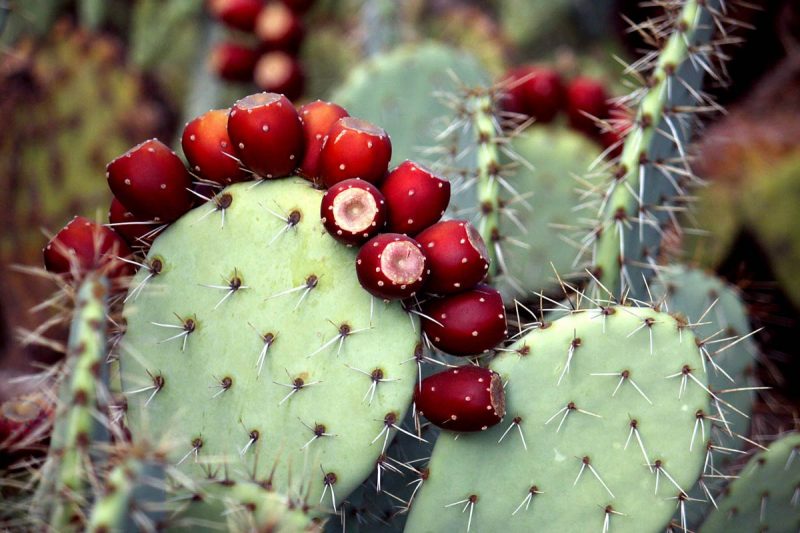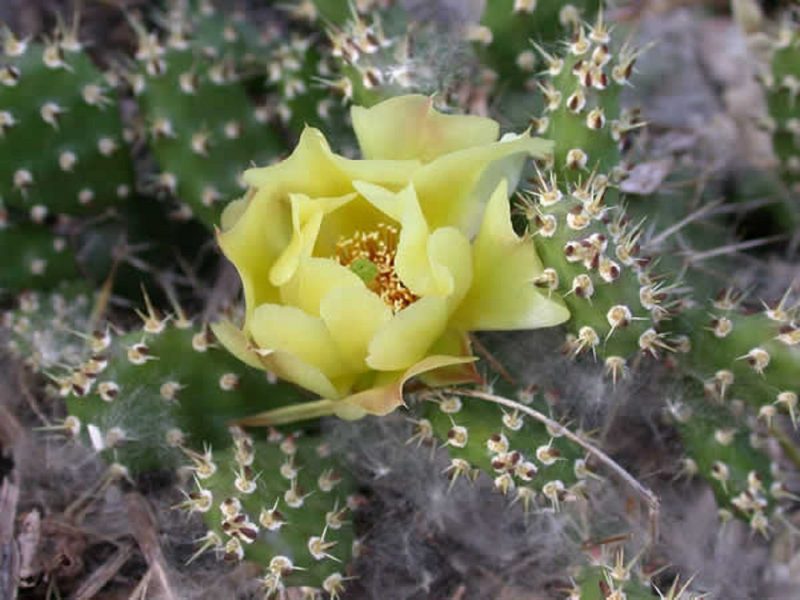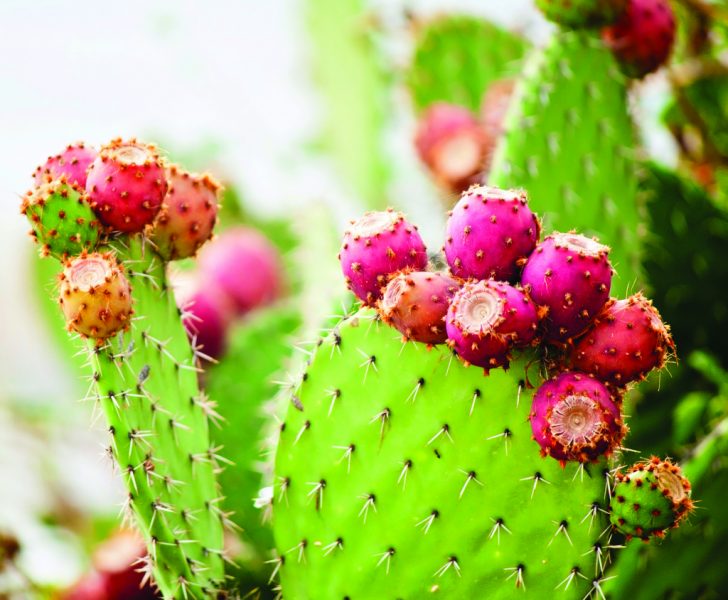Prickly pear - a succulent with an unusual stem, consisting of flat, fleshy discs. This plant decorates the room, creating a pleasant and comfortable atmosphere, conducive to communication. To avoid growing problems, you need to follow simple rules common to all cacti.
Material Content:
Description of types and varieties of prickly pear
Prickly pear belongs to the cactus family. In nature, some species have long, prickly glochidia.

For growing in apartments, the following types are popular:
- prickly pear - stems are cylindrical, branching, grows to a height of 1.8 m, blooms in large pink flowers;
- prickly pear - suitable for growing indoors, blooms beautifully with lemon-yellow flowers, has a small size (up to one meter), glochidia are very small and prickly, leave a burning sensation on the skin from contact;
- prickly pear - frost-resistant appearance, can grow not only in the room, but also in open ground, tolerates air temperature -25 ° C without shelter, the stem is smooth, without needles, blooms in summer with yellow flowers.
Some varieties of cactus can decorate a garden in central Russia. For example, prickly pear cactus is a frost-resistant species that grows in the open ground, wintering in the snow, without shelter, the homeland of North America, blooms in large yellow flowers, on the stem grow sharp glochidia up to 4 cm long.
Home care and growing
Care for prickly pear is reduced to proper transplantation, sparse watering and fertilizer, protection against diseases and pests. When transplanting cacti, handle them carefully.Spines (glochidia) stick to the skin, can break off and cause inflammation.
Plant conditions
A flower pot is placed on the lightest window sill. The trunk is tied to a reliable support so that it does not fall to the side when the prickly pear grows.

The planting capacity must be stable, sometimes a heavy river stone is placed on its bottom so that the plant does not accidentally turn over. Loose soil, where moisture does not linger, is an ideal place for planting. Its excess can lead to disease and death of the flower.
How to water a cactus at different times of the year
In summer, water the cactus sparingly. Plants hibernate at low temperatures with little or no watering; they resume it after the formation of flower buds.

If prickly pears are wintering in a warm room, at an air temperature of +20 ° C, they are watered in the same way as in summer, but they are not fed.
Fertilizing and fertilizers
Opuntia is fed once a week with fertilizers for cacti. You can use preparations for decorative foliage plants diluted with water four times more than indicated in the instructions.

The ratio of N, P, K in the right fertilizer should be 5-10-5 or 20-30-20. Organic feeding for cacti is not used. Sick, just bought or transplanted plants do not fertilize.
Prickly pear flowering
A beautiful flower opens only for one day, and then fades. Opuntia cactus rarely blooms at home, but it is an unforgettable sight.

The fruits of some species, for example, prickly pear prickly pear, are edible and very tasty, somewhat reminiscent of strawberries.
As an edible plant, fig or Indian prickly pear is cultivated. Its fruits with juicy, sweet pulp are eaten fresh, jam is made from them.
How to propagate and plant prickly pear
They grow prickly pears from seeds and cuttings. Cuttings (segments of the stem) are dried for 3 hours before planting, then planted in a slightly moist, loose soil. Rooting occurs after about 3 weeks.
Opuntia seeds are sown in small containers with soil (a mixture of sand and garden soil). The soil is moistened from the spray as it dries. The emerged shoots do not look like cacti, they have two small leaves, like ordinary grass. Then from the top begins to grow the stem of the prickly pear, and the seedlings dive into separate pots.
Pest and Disease Control

Most ailments of prickly pear are easier to prevent than to cure, they appear due to improper care:
- Cactus late blight - the pathogenic fungus pathogen turns the stem into a sour mass.
- Rhizoctonia or wet rot looks like a darkening or blackening of a cactus stem. The cause of the disease is land infected with pathogenic fungi. To avoid the occurrence of rhizoctonia, before planting a cactus, the soil from the garden is disinfected.
- Fusarium - the stem of the prickly pear falls, changes color to reddish or purple, the root system rots.
If the rot affects the root of the prickly pear, there are two treatment options, which one to choose depends on the degree of the disease. When the roots rotted only partially, they use a transplant in fresh soil, all patients, softened roots are removed, the remaining ones are sprinkled with sulfur or crushed activated carbon. For the treatment of root rot effective fungicide "Maxim". If the roots have rotted completely, transplanting will not help. In this case, cut off the healthy part of the stem, and root it like a stalk.
When the stem rots, damaged tissue is cut with a blade, a sore spot is treated with fungicide.
Pest insects can also cause stunting and dropping buds.

The main pests of prickly pear:
- Ticks - the stem of the affected plant becomes covered with rust spots or plaque. Acaricides are used for treatment (Actellik, Neoron, Apollo, Fufanon).
- Worms - infected plants become faded, wither, can die.To combat insects, the prickly pear is removed from the pot, washed with hot water (50 ° C), treated with a strong solution of Fitoverm, transplanted into clean ground.
- Scaffold and false scaffold - the stem is covered with sticky secretions of insects, they are noticeable in the form of flat brown scales. Infected prickly pears are watered with a solution of Actara or Confidor.
Before you bring into the room the plants that stood in the summer in the garden or on the veranda, carefully inspect for pests.
Possible growing problems
Growing problems are most often caused by errors in care.

Description of symptoms and possible causes of ailments of prickly pear:
- stunt can be observed with insufficient lighting, watering with cold water, improper transplantation, after abundant flowering;
- plant drying in moist soil, it speaks of root decay, which requires an urgent transplant, if it is impossible to save the plant, break off a healthy shoot, and root in the sand;
- extinction of the aerial part occurs when the roots are damaged, if the plant is improperly transplanted, or excessively watered;
- spots and yellowing on the skin appear due to sunburn, if the flower was standing in a cold draft, with an insufficient amount of nutrients in the soil, with damage by pests;
- lack of flowering It is caused by insufficient lighting.
The appearance on the stem of concentric spots, rings, specks in a certain sequence causes the prickly pear virus. Florists advise to use in such cases antiviral drugs that are sold in pharmacies for people, for example, Rimantadine (2 tablets per 1 liter of water).
Growing prickly pears does not cause much trouble, it does not require frequent watering and top dressing. If you take care correctly, you can admire the beautiful flowers, and taste the exotic fruits of prickly pears with strawberry flavor.












